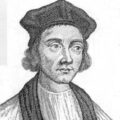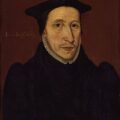
“Certain men of the parish came unto him, and earnestly entreated that considering the multitude was great, and that it was pity they should be disappointed of their expectation, that it would please him to take the place for that time. But he excused his age and the infirmities thereof, and that his memory failed him, his voice scarce to be heard, and he not able to do it, that they would hold him excused. Nevertheless such were their importunate requests that, would he nould he, he must and did yield unto their requests: and between two men he was carried up into the pulpit, where God did with his spirit so strengthen him, that he made his last and the best and the most godly sermon that ever he did in all his life. And very shortly after he died, being very honourably buried with the presence of the duchess of Suffolk, the earl of Bedford, and many others, honourable and worshipful personages.”
Coverdale was laid to rest in the chancel of St Bartholomew by the Exchange but his remains were moved in 1840 when the church was demolished. He was re-interred at the church of St Magnus the Martyr.
Here are some facts about Miles Coverdale:-
- He was born c1488 in Yorkshire, making him around 80 when he died
- He was ordained as a priest in Norwich
- He became an Augustinian friar and was part of an order in Cambridge where he was influenced by the prior, Robert Barnes, who was sympathetic to religious reform
- Coverdale took a degree at Cambridge – Foxe says a BTh and Cooper says a BCL
- He met Thomas Cromwell in the 1520s
- “By Lent 1528 he had left the Augustinians and ‘going in the habit of a secular priest’ (Acts and Monuments, ed. Pratt, 5.40) he preached in Essex against transubstantiation, the worship of images, and confession to the ear” – His ‘heretical’ views led to him having to flee to the Continent in exile at the end of 1528
- In exile, according to John Foxe, Coverdale worked closely with Bible translator William Tyndale
- In 1534 Coverdale translated Campensis’s 1532 Latin paraphrase on the psalms
- On 4th October 1535 Coverdale’s translation of the Bible, the Coverdale Bible, was printed. He “was the first to translate and print the entire Bible in English”
- Coverdale returned to England in late 1535
- In 1537 and 1538, at Cranmer and Cromwell’s request, Coverdale oversaw a revision and reprinting of “The Matthew’s Bible”. Unfortunately, all bound copies were burned but Cromwell was able to initiate fresh printing. It was called “The Great Bible”
- Coverdale was forced into exile again, with his new bride Elizabeth Macheson, due to the 1539 Act of Six Articles
- While in exile, he obtained his DTh and became an assistant preacher and headmaster of a school in Bergzabern, near Strasbourg, where he also met Conrad Hubert, Martin Bucer’s secretary
- In exile he translated German tracts and produced his “Defence of a Certayne Poore Christen Man”
- All of Coverdale’s books were condemned on the 8th July 1546 and many were burned at St Paul’s Cross on the 26th September 1546 by Bishop Bonner
- Coverdale returned to England from exile in 1548
- He became almoner to the Dowager Queen Catherine Parr and preached at her funeral in September 1548. He then became a royal chaplain to Edward VI
- Coverdale was involved in pacifying the rebels in the Prayer Book Rebellion of 1549, doing the work of the elderly Bishop of Exeter
- He was a member of the 1551 commission appointed to deal with Anabaptists
- On the 14th August 1551 he became Bishop of Exeter
- He regularly attended the House of Lords and was a member of the 1552 commission reforming canon law
- He remained an active preacher
- In 1553 he was ejected from his seat of bishop by Mary I
- In 1555 Mary I allowed Coverdale to travel to Denmark. He then made his way back to Bergzaben
- In 1558 he became an elder of a church in Geneva
- He returned to England in August 1559, lodging with the Duchess of Suffolk
- In January 1564, Edmund Grindal, Bishop of London, offered Coverdale the living of St Magnus the Martyr by London Bridge
- Coverdale survived a dose of the Plague in 1563
- His wife Elizabeth died in September 1565 and Coverdale married his second wife, Katherine, on the 7th April 1566
- He resigned from St Magnus the Martyr in the summer of 1566 but continued preaching actively in London even though he was in his 70s
- He preached right up to his death on 20th January 1569
Notes and Sources
- David Daniell, ‘Coverdale, Miles (1488–1569)’, Oxford Dictionary of National Biography, Oxford University Press, 2004








